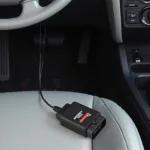Creating a low-cost Arduino CAN bus ECU OBD2 simulator is a fantastic way to delve into the world of automotive diagnostics and electronics. This guide provides a comprehensive overview of building your own simulator using readily available and affordable components, perfect for hobbyists, students, and professionals looking to understand OBD2 communication. Let’s get started!
Understanding the Components of a Low-Cost Simulator
Building an OBD2 simulator involves understanding the core components and how they interact. The key elements include:
- Arduino Board: The brain of our operation. A common choice is the Arduino UNO due to its accessibility and affordability. It provides the platform for programming and controlling the simulator.
- CAN Bus Shield: This shield adds CAN bus capabilities to the Arduino. The MCP2515 CAN controller is a popular choice for this, allowing the Arduino to send and receive CAN messages.
- OBD2 Connector: A standard OBD2 connector allows you to interface the simulator with a vehicle’s OBD2 port or other diagnostic tools.
- Power Supply: A stable 5V power supply is typically required to power the Arduino and the CAN bus shield.
Setting Up Your Arduino CAN Bus ECU OBD2 Simulator
The setup process is straightforward, but requires attention to detail. Follow these steps:
- Install the CAN Bus Library: Install the necessary CAN bus library for your Arduino IDE. This library allows you to control the MCP2515 CAN controller.
- Connect the CAN Bus Shield: Carefully attach the CAN bus shield to your Arduino board, ensuring proper alignment.
- Wiring: Connect the CAN bus shield to the OBD2 connector following the OBD2 wiring standards. Pay close attention to the CAN High (CANH) and CAN Low (CANL) pins.
- Upload the Code: Upload the code to your Arduino. This code will dictate the simulator’s behavior, allowing you to simulate specific ECU responses and data.
Programming Your Simulator
The real power of your simulator lies in the software. You can program the Arduino to simulate various ECU behaviors and data. This can include:
- Simulating Sensor Readings: Simulate sensor data like engine speed, coolant temperature, and oxygen sensor readings.
- Simulating Fault Codes: Simulate Diagnostic Trouble Codes (DTCs) to test diagnostic tools and procedures. open source obd2 hardware may be useful in this endeavor.
- Responding to OBD2 Requests: Program your simulator to respond to standard OBD2 requests for data using PIDs (Parameter IDs).
“The flexibility of an Arduino-based OBD2 simulator is truly remarkable,” says Dr. Emily Carter, Automotive Electronics Engineer. “You can tailor the simulation to specific needs, making it an invaluable tool for testing and development.”
Advanced Features and Considerations
Once you have a basic simulator working, consider exploring more advanced features:
- Real-Time Data Simulation: Simulate changing data in real-time to more closely mimic a real vehicle’s behavior.
- Custom Protocols: Implement custom communication protocols beyond standard OBD2. An arduino obd2 scanner might provide a useful foundation.
- Data Logging: Log the data transmitted and received by the simulator for further analysis. An obd2 monitor simulator can help visualize this data.
“Building an OBD2 simulator is a fantastic learning experience,” adds Michael Davis, Automotive Technician. “It allows you to understand how OBD2 works on a fundamental level.”
Conclusion: Your Low-Cost, Powerful Tool
Building a low-cost Arduino CAN bus ECU OBD2 simulator opens up a world of possibilities for automotive diagnostics and experimentation. With a bit of effort, you can create a powerful tool tailored to your specific needs.
FAQ
- What is CAN bus? CAN bus (Controller Area Network) is a robust vehicle communication system used for various functionalities, including diagnostics.
- Why use an Arduino? Arduino’s ease of use, affordability, and large community support make it ideal for this project.
- What is an ECU? An ECU (Engine Control Unit) is the main computer that controls a vehicle’s engine.
- What is OBD2? OBD2 (On-Board Diagnostics II) is a standardized system for accessing vehicle diagnostic information.
- Why build a simulator? A simulator enables safe and controlled testing of diagnostic tools and software without needing a real vehicle.
- What is a CAN bus shield? A CAN bus shield provides the necessary hardware to allow the Arduino to communicate on the CAN bus.
- What is the MCP2515? The MCP2515 is a commonly used CAN controller chip.
For further assistance, please contact us via WhatsApp: +1(641)206-8880, Email: [email protected] or visit us at 789 Elm Street, San Francisco, CA 94102, USA. Our 24/7 customer service team is always ready to help.
